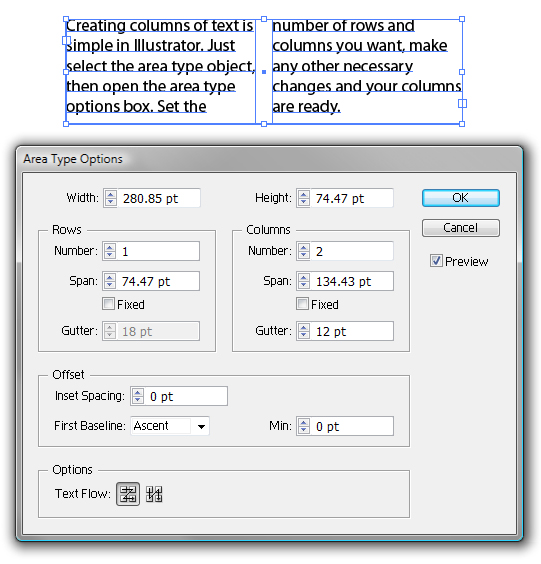

The problem with using Illustrator's Use Preview Bounds setting is that it does just that: It simply causes the height and width fields to display measure values of the "painted" result of effects applied to the paths. A flourish of a decorative script may exceed the bounds of the em square both horizontally and vertically (something not even possible in the pre-digital physical type slugs often cited as the reason for why type size is not specified according to the actual height of the glyph outlines). The actual glyph shapes are drawn in relative position to the em square, but are not necessarily constrained to fit within it. So the em square serves as the "proportional equalizer" within a typeface. to be correctly proportional to the non-italics. So you wouldn't want the specified type size to be an actual measure of the glyphs you'd want the glyphs of the italics, punctuation marks, symbols, etc. In a line of type, if you change a word or phrase to, for example, the italic version of the same font, the actual height measures often differ from the corresponding regular glyph. They vary widely in stylistic shape geometric sans-serifs to flourishing scripts and everything in between. Ascenders and descenders differ in their heights. Rounded characters are taller than other characters. The reason is not just an archaic throwback to pre-computer type casting.Įven in a single typeface, not all glyphs measure the same height. When you specify type size in software, you are specifying the height of the em square and the glyphs are scaled proportionally and positioned relatively to it. It is the way that fonts are designed.Ī typeface is designed on an imaginary relative space called the em square.

You'll notice that letters that are flat on the top and bottom, such as an I or H, are shorter than rounded letters like O and Q.

It doesn't matter exactly where the guides are as long as they are 4 inches apart.Īdd the text and increase the point size in the Control panel until the letters are 4 inches tall and match up with the guides. I have a ruler guide at the top of the artboard and one at the 4 inch mark. Then select the black selection tool, put your cursor inside the horizontal ruler at the top of the window, press and drag down onto the artboard. If the units are not inches, right-click inside a ruler and choose inches. If the rulers aren't showing, choose View > Show Rulers. I would suggest that you add a couple of horizontal ruler guides. But never mind the reason - you need a solution for your use. The reason goes back to before computers when each letter was a physical letter on a block.


 0 kommentar(er)
0 kommentar(er)
